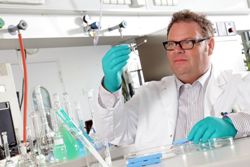May 21 2010
The transplantation of cornea can restore the vision of blind patients who had lost their eyesight after an illness or accident.
 "Dr. Joachim Storsberg working on a synthetic corneal implant"
"Dr. Joachim Storsberg working on a synthetic corneal implant"
Thankfully there are cornea donors who give hopes of restoring vision to about 7000 people in Germany and 40,000 in Europe every year. However, the corneas from donor are not very common. Dr. Joachim Storsberg from Potsdam-Golm’s Fraunhofer Institute for Applied Polymer Research IAP devised the material and manufacturing methodology for a corneal prosthesis, which is made up of plastic. This can aid patients whose donor corneas are damaged, or who are incapable of tolerating the donor corneas because of particular conditions of the disease. Dr. Storsberg is honored with the 2010 Joseph von Fraunhofer Prize as an acknowledgment for this effort.
The artificial cornea is miniscaled, and it has to fulfill the entire contradictory conditions. First, the material must grow firmly along with the cells present in the neighboring tissue. Second, there must not be any cells settling in the artificial cornea’s optical region, as this would damage the eyesight again. Finally, the implant’s outer side should be capable of moistening with tear fluids or else the anterior side of the implant will get clouded up and this will call for replacement of the artificial cornea in a short period. Also moistening with tears will enable the eyelid’s free movement across the implant.
Dr. Storsberg discovered a hydrophobic polymer material solution. Previously, the polymer material was employed in the field of ophthalmology, namely, in intraocular lenses. A complete modification required for fulfilling the numerous characteristics involved was done to the material on a polymer-chemical basis. Then it was tested again for the approval from public.
Initially, the implant’s edge was given a coating of several special polymers, so as to attain the preferred characteristics. Subsequently, a special protein comprising the particular growth factor sequence was added. The growth factor is identified by the neighboring natural cells, and they are encouraged to populate the margin area of the cornea. Therefore, the neighboring tissue’s cells and the implant grow together and thus the artificial cornea gets stability.
The eye prosthesis is a result of the cooperation of manufacturers and physicians in the “Artificial Cornea” EU project. The team of the interdisciplinary research required three years to devise the artificial cornea. The manufacturing of the implant was done by miro GmbH. The sales, distribution and the specially modified implantation centers of Europe were backed up by robin GmbH. Previously in 2009, a prosthesis was employed with success and in the first half of 2010 additional implantations are expected.